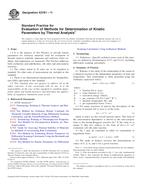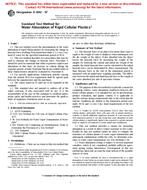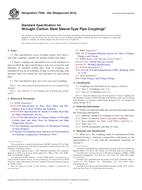Click here to purchase
^SCOPE:
1.1 This test method describes the general requirements for evaluating the long-term, chlorinated water, oxidative resistance of cross-linked polyethylene (PEX) tubing produced in accordance with Specification F 876 or PEX tubing/fitting systems in accordance with Specification F 877 used in hot-and-cold water distribution systems by exposure to hot, chlorinated water. This test method outlines the requirements of a pressurized flow-through test system, typical test pressures, test-fluid characteristics, failure type, and data analysis.
Note 1 – Other known disinfecting systems (chlorine dioxide, ozone, and chloramines) are also used for protection of potable water. Free-chlorine is the most common disinfectant in use today. A PPI research project examined the relative aggressiveness of free chlorine and chloramines on PEX pipes, both a the same 4.0 ppm concentration and the same test temperatures. The results of the testing showed pipe failure times approximately 40% longer when tested with chloramines compared to testing with free chlorine, at the tested conditions. Based on these results, the data suggests that chloramines are less aggressive than free chlorine to PEX pipes.
1.2 Guidelines and requirements for test temperatures, test hoop stresses, and other test criteria have been established by prior testing of PEX tubing produced by the three most common commercial methods of cross-linking: silane, peroxide, and electron-beam (see Note 2). Other related system components that typically appear in a PEX hot-and-cold water distribution system can be evaluated with the PEX tubing. When testing PEX tubing and fittings as a system, it is recommended that the anticipated end-use fitting type(s) and material(s) be included in the test circuit since it is known that some fitting types and materials can impact failure times. Specimens used shall be representative of the piping product(s) and material(s) under investigation.
Note 2 – The procedures described in this test method (with some modifications of test temperatures or stresses, or both) have been used to evaluate pipes manufactured from polybutylene (PB), polyethylene (PE), polypropylene (PP), multilayer (polymer-metal composite), copper, and stainless steel.
1.3 This test method is applicable to PEX tubing and systems used for transport of potable water containing free-chlorine for disinfecting purposes. The oxidizing potential of the test-fluid specified in this test method exceeds that typically found in potable water systems across the United States.
1.4 The values stated in inch-pound units are to be regarded as the standard. The values given in parentheses are for information purposes.
1.5 The following precautionary caveat pertains only to the test method portion, Section 12, of this specification. This standard does not purport to address all of the safety concerns, if any, associated with its use. It is the responsibility of the user of this standard to establish appropriate safety and health practices and determine the applicability of regulatory limitations prior to use.
Product Details
- Published:
- 03/01/2008
- Number of Pages:
- 7
- File Size:
- 1 file , 140 KB
- Redline File Size:
- 2 files , 260 KB


